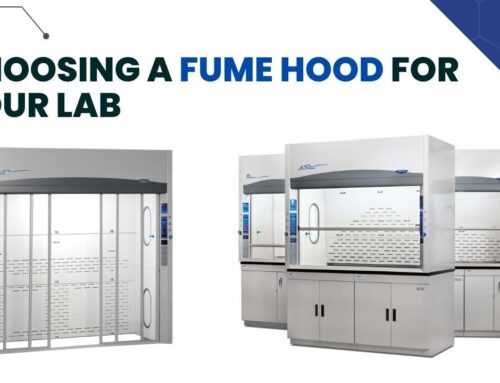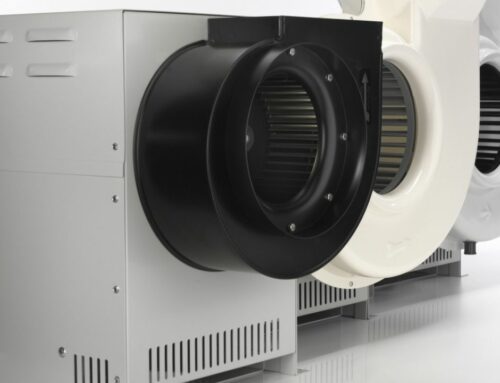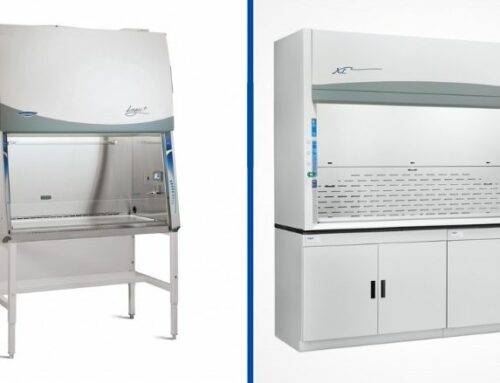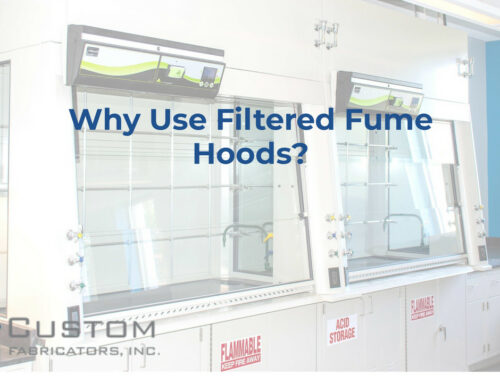Specialty Fume Hoods
Fume hoods remove harmful and toxic fumes or vapors from the lab. They provide personnel protection against inhalation, chemical spills, reactions, and fire.
The primary objective of ventilated enclosures, including laboratory fume hoods and biosafety cabinets (BSCs), is to protect personnel, product/experiment, and the environment from lab hazards. It’s crucial to select the right type of hood for your needs; however choosing the correct type of hood may not be as intuitive as choosing other basic laboratory equipment.
The various types of fume hoods include chemical, benchtop, floor-mounted, ducted vs. ductless, high performance, and low flow. There are also special fume hoods designed for special applications, which involve radiochemicals and harsh acids that are remarkably hazardous in unique ways. These include acid digestion fume hoods, perchloric acid fume hoods, and radioisotope fume hoods.
The right choice for your lab will depend on multiple factors, including the intended use or application. The safety of your users should always be the number one priority. Other considerations include the lab size, budget, and energy efficiency. Some institutions do not allow ductless fume hoods in radiological environments.
Acid-resistant fume hoods
You can use dilute acids at room temperature in most fume hoods. However, you will need an acid hood for acid digestion, heating, or working with concentrated acids such as hydrofluoric or nitric acid.
An acid hood is engineered for highly corrosive operations involving dissolution procedures for element analysis. Some of these hoods may be constructed from polypropylene, which is long-lasting and can withstand harsh chemicals for years.
Features
The standard features of acid-resistant fume hoods include:
- Unplasticized polyvinyl chloride (u-PVC) or polypropylene (PP) liners and integral work surfaces. The u-PVC or PP lining has superior chemical resistance—the ability to withstand reactions from strong and corrosive acids used in acid digestion applications.
- Polycarbonate sash windows to resist etching by hydrofluoric acid and increase visibility, or tempered glass sash for other applications.
- Vapor proof LED lighting.
- Other requirements necessary for successful installation, which may include ductwork and a PVC blower.
Additional accessories that optimize the functionality of fume hoods in undertaking acid digestion operations include:
- Exhaust washdown with drain trough
- Remote control service valves
- Teflon™ spray gun
- Flexible vent kit for base cabinet
- Airflow monitors to ensure user safety
- Lattice kit for complex glassware setups
- Vented fume hood base cabinet
- GFCI outlets
Applications
These hoods are ideal for applications that require acid-resistant fume hoods, including labs analyzing rare elements and biochemistry labs researching trace metals. They are also best for wastewater treatment facilities and food safety agencies that test for toxic elements such as mercury.
Note: Acid-resistant fume hoods are not for use in perchloric acid applications.
PVC Perchloric Acid Fume Hood
Perchloric acid is a clear, colorless liquid known as HCIO4. Itcan be explosively unstable under certain conditions.
For example, when heated, it vaporizes and condenses to form metallic perchlorates on the hood, duct, and fan components. The condensed vapors are highly corrosive and react with hood gaskets, greasers, and collected materials to form explosive perchlorate salts. Perchloric salts are highly volatile and sensitive to shocks and vibrations, including the normal working vibrations of a fume hood.
Only special laboratory hoods, such as the PVC perchloric acid fume hoods, are explicitly designed for perchloric acid procedures. The hood surface liners are of Type 1 u-PVC, which can withstand the corrosive properties of perchloric acid.
The exhaust duct ideally takes the shortest route to vent into the atmosphere. It is also not uncommon for a perchloric acid fume stream to be separated from other ductwork and streams.
These laboratory hoods also contain washdown systems that inhibit crystal formation within the fume hood and the exhaust ductwork.
Features
- Built-in washdown systems remove hazardous percolates that may have accumulated in the hood’s corners and baffles through a series of water sprays.
- Heat-welded u-PVC interior with coved corners and seamless design for easy cleaning of the surface from perchlorate salts.
- Integral work surfaces and drainage troughs to facilitate easy rinsing after each use.
- Bypass airflow design.
- Thick tempered safety glass, or polycarbonate vertical-rising sash.
- Pre-wired electrical components such as vapor-proof LED lighting
Applications
PVC perchloric acid fume hoods are a great alternative in highly corrosive applications where you cannot use metal or stainless. They are ideal for applications involving perchloric acid and other inorganic chemicals that do not involve high temperatures.
Stainless Steel Perchloric Acid Fume Hood
This hood’s interior linings are stainless steel with rounded corners for easy cleaning. It is designated for use when handling or performing a reaction with perchloric acid.
Features
Standard features for stainless steel perchloric acid fume hoods include:
- Built-in washdown system
- Stainless steel liner with radiused corners, integral work surface, drainage trough, and pre-set baffle(s)
- Bypass airflow design and bypass block
- Tempered safety glass vertical-rising sash with cable and pulley
- Removable panels for access to plumbing and electrical wiring
- Pre-wired electrical components and bright interior lighting
- The full view sash provides an unobstructed view of the hood interior
- Other requirements essential for proper installation include a dedicated remote PVC blower, wash rings, ductwork, and base cabinets or stand
Benefits
Aside from the basic need to provide containment of harmful vapors, the two primary objectives in the installation of a perchloric acid fume hood system are to:
- Prevent accumulation of deposits by use of a washdown system
- Avoid corrosive action of perchloric acid on any of the components.
Radioisotope fume hoods
Radioisotope fume hoods provide a safe and convenient environment for handling low-level radioactive material. The liner is impervious to radioactive material such as stainless steel. They also feature integral work surfaces and radiused interiors to facilitate decontamination. Radioisotope hoods are typically sturdy enough to support lead-shielding bricks. They require the installation of high-efficiency particulate air (HEPA) or carbon filters in the ductwork to trap the radioactive materials emitted during a particular application.
Protector stainless steel radioisotope laboratory hood
This hood protects applications that require the use of radiochemicals. Most models feature:
- Bypass airflow design for stable face velocity
- Stainless steel baffle and liner for superior chemical resistance, strength, and durability with radiused corners, integral work surface, and pre-set baffle(s)
- Tempered safety glass vertical-rising sash with cable and pulley
- Removable panels for access to plumbing and electrical wiring
- Pre-wired electrical components, LED lighting, and airflow monitors
Applications
The hoods are best for various applications, including the use of radiochemicals. They are also common in nuclear medicine and microelectronics.
Special fume hood extras
When installing special fume hoods, you may need to purchase or install other accessories to get them up and running. Common accessories include:
- Fume hood blowers
- Ductwork, filter packs, and all the transition pieces needed to complete your exhaust system
- Base or cabinet stands
- Optional accessories may include airflow monitors, sash stop kits, ceiling enclosures, and rear finish panel kits
Hood lining material
The purpose of fume hood liners is to ensure the longevity of your fume hood. Hood liners are subject to attack from acid fumes and solvent vapors causing corrosion, dissolution, and melting; so they must be compatible with the chemicals used. The most common liner types include:
Stainless steel liner fume hoods. These are generally resistant to corrosion and offer robust support for lead-shielding weight. These liners are easy to decontaminate.
Stainless steel is available in various grades, offering varying performance and functionality. For example, Type 304 stainless steel liners work best in radioisotopes applications. They also have excellent moisture and heat resistance.
Type 316 stainless steel liners are typical for perchloric acid applications since they have better overall corrosion resistance properties. Though they offer resistance to a wide range of chemicals, they are not compatible with some inorganic acids and metal scavengers.
- Epoxy Coated Steel: These work best in non-corrosive to moderately corrosive environments. They have high chemical resistance and are economical. However, acids can quickly corrode the carbon steel if exposed.
- Polyvinyl Chloride (PVC): This liner is made with one of the most chemical-resistant materials. It is best for typical applications involving acid digestions with perchloric, hydrofluoric, sulfuric, and nitric acids.
Laboratory countertops to consider
Selecting the right laboratory countertop material is essential in maintaining integrity under regular use. There are various types of countertop materials. The right fit will depend on the intended use or application. They include:
- Polyvinyl Chloride (PVC): These countertops are made of plastic composite, offering a high chemical resistance. PVC is economical, durable, and readily available. It is easy to maintain and does not stain easily. However, it offers low heat resistance.
- Phenolic Resin: Common brand names are TRESPA and FunderMax. Phenolic resin has good chemical, bacterial, fungal, and moisture resistance. It is easier to fabricate and customize and is available in a wider range of colors to match specific applications or designs. However, it has low resistance to caustic chemicals and should not be exposed to UV rays for long periods.
- Epoxy Resin: This countertop has a high heat resistance of 350F+. Since epoxy resin has high tensile, flexural, and comprehensive strengths, it holds up to impact and stress. It is versatile and highly resistant to chemicals, fungi, bacteria, moisture, and corrosion. However, these countertops are costly with a long lead time because only two epoxy resin countertop manufacturers exist in the US.
- High-pressure laminate (HPL): HPL offers a functional, durable, and decorative work surface. It works best in product testing, technology labs, and other dry applications. It has low bacterial, fungal, chemical, water, and moisture resistance.
- Stainless Steel: These are made from low-carbon steel—a combination of nickel and chromium. They are a non-porous surface, offering high bacterial and fungal resistance. They also have a heat resistance of about 15000 F, but may discolor with prolonged high temperatures. They may dent on impact and are not scratch resistant.
- Polypropylene is a thermostatic polymer that offers high resistance to chemicals and moisture. Since it is metal-free, it is ideal for labs that use highly corrosive materials. Polypropylene is a soft surface that is sensitive to scratches.
- High-Density Polyethylene (HDPE): This is a lightweight alternative to stain, chemical, and corrosive-resistant countertop material. It is available in various colors. However, HDPE is not heat resistant and may melt when exposed to high heat.
How can CFI help?
Not sure which fume hood is best for your lab? Let CFI fume hood experts help you. They will analyze your application and recommend the appropriate fume hood for your laboratory. They can also customize a fit for your operations and budget
FAQ
Can perchloric acid be used in any fume hood?
Perchloric acid vapors can condense in the fume hood ductwork to form perchlorate salts at elevated temperatures. These salts are often highly shock-sensitive and pose a severe explosion hazard. Any heating of perchloric acid or greater concentrations requires a specially dedicated laboratory fume hood equipped with a washdown system.
Can a fume hood protect against radioactivity?
Not all of them; only those specifically designed to protect the user and surrounding space from radioactivity can do so. Their interior consists of a stainless steel coating which helps with decontamination.
Can radioactive materials be used in fume hoods?
The rules for working safely with radioactive material require all exposures to be As Low As Reasonably Achievable (ALARA). Hence radioisotope fume hoods provide a safe and convenient environment for handling low-level radioactive material.






